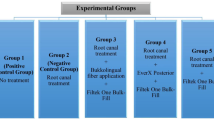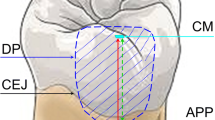Abstract
This study tested the impact of Gluma Desensitizer on the tensile strength of zirconia crowns bonded to dentin. Human teeth were prepared and randomly divided into six groups (N = 144, n = 24 per group). For each tooth, a zirconia crown was manufactured. The zirconia crowns were cemented with: (1) Panavia21 (PAN), (2) Panavia21 combined with Gluma Desensitizer (PAN-G), (3) RelyX Unicem (RXU), (4) RelyX Unicem combined with Gluma Desensitizer (RXU-G), (5) G-Cem (GCM) and (6) G-Cem combined with Gluma Desensitizer (GCM-G). The initial tensile strength was measured in half (n = 12) of each group and the other half (n = 12) subjected to a chewing machine (1.2 Mio, 49 N, 5°C/50°C). The cemented crowns were pulled in a Universal Testing Machine (1 mm/min, Zwick Z010) until failure occurred and tensile strength was calculated. Data were analyzed with one-way and two-way ANOVA followed by a post hoc Scheffé test, t test and Kaplan–Meier analysis with a Breslow–Gehan analysis test (α = 0.05). After the chewing simulation, the self-adhesive resin cements combined with Gluma Desensitizer showed significantly higher tensile strength (RXU-G, 12.8 ± 4.3 MPa; GCM-G, 13.4 ± 6.2 MPa) than PAN (7.3 ± 1.7 MPa) and PAN-G (0.9 ± 0.6). Within the groups, PAN, PAN-G and RXU resulted in significantly lower values when compared to the initial tensile strength; the values of all other test groups were stable. In this study, self-adhesive resin cements combined with Gluma Desensitizer reached better long-term stability compared to PAN and PAN-G after chewing simulation.








Similar content being viewed by others
References
Sturzenegger B, Fehér A, Lüthy H, Schärer P, Gauckler LJ (2001) Reliability and strength of all-ceramic dental restorations fabricated by direct ceramic machining (DCM). Int J Comput Dent 4:89–106
Lüthy H, Filser F, Loeffel O, Schumacher M, Gauckler LJ, Hämmerle CHF (2005) Strength and reliability of four unit all-ceramic posterior bridges. Dent Mater 21:930–937
Fischer J, Stawarczyk B (2007) Compatibility of machined Ce-TZP/Al2O3 nanocomposite and a veneering ceramic. Dent Mater 23:1500–1505
Piconi C, Maccauro G (1999) Zirconia as a ceramic biomaterial. Biomaterials 20:1–25
Abo-Hamar SE, Hiller KA, Jung H, Federlin M, Friedl KH, Schmalz G (2005) Bond strength of a new universal self-adhesive resin luting cement to dentin and enamel. Clin Oral Investig 9:161–167
Bindl A, Richter B, Mörmann WH (2005) Survival of ceramic computer-aided design/manufacturing crowns bonded to preparations with reduced macro-retention geometry. Int J Prosthodont 18:219–244
Burke FJT, Fleming GJP, Nathanson D, Marquis P (2002) Are adhesive technologies needed to support ceramics? An assessment of the current evidence. J Adhes Dent 4:7–22
Stewart GP, Jain P, Hodges J (2002) Shear bond strength of resin cements to both ceramic and dentin. J Prosthet Dent 88:277–284
Burke FJT, Qualthrough AJE, Hale RW (1998) Dentin-bonded all-ceramic crowns: current status. J Am Dent Assoc 129:455–460
Knobloch LA, Kerby RE, Seghi R, Berlin JS, Lee JS (2000) Failure toughness of resin-based luting cements. J Prosthet Dent 83:204–209
Mitchell CA, Douglas WH, Cheng YS (1999) Failure toughness of conventional, resin-modified glass-ionomer and composite luting cements. Dent Mater 15:7–13
Piwowarczyk A, Lauer HC, Sorensen JA (2005) Microleakage of various cementing agents for full cast crowns. Dent Mater 21:445–453
Yang B, Ludwig K, Adelung R, Kern M (2006) Micro-tensile bond strength of three luting resins to human regional dentin. Dent Mater 22:45–56
Behr M, Rosentritt M, Regnet T, Lang R, Handel G (2004) Marginal adaptation in dentin of a self-adhesive universal resin cement compared with well-tried systems. Dent Mater 20:191–197
Rosentritt M, Behr M, Lang R, Handel G (2004) Influence of cement type on the marginal adaption of all-ceramic MOD inlays. Dent Mater 20:463–469
Blatz MB, Sadan A, Martin J, Lang B (2004) In vitro evaluation of shear bond strength of resin to densely-sintered high-purity zirconium oxide after long-term storage and thermal cycling. J Prosthet Dent 91:356–362
Kern M, Wegner SM (1998) Bonding to zirconia ceramic: adhesive methods and their durability. Dent Mater 14:64–71
De Munck J, Vargas M, Van Landuyt K, Hikita K, Lambrechts P, Van Meerbeek B (2004) Bonding of an auto-adhesive luting material to enamel and dentin. Dent Mater 20:963–971
Bayle MA, Gregoire G, Sharrock P (2007) The role of acrylophosphonic acid monomers in the formation of hybrid layers based on self-etch adhesive. J Dent 35:302–308
Richardson D, Tao L, Pashley DH (1991) Dentin permeability: effect of crown preparation. Int J Prosthodont 4:219–225
Pashley DH, Pashley EL (1991) Dentin permeability and restorative dentistry: a status report for the American Journal of Dentistry. Am J Dent 4:5–9
Watanabe T, Sano M, Itoh K, Wakumoto S (1991) The effect of primers on the sensitivity of dentin. Dent Mater 7:148–150
Schüpbach P, Lutz F, Finger WJ (1997) Closing of dentinal tubules by Gluma Desensitizer. Eur J Oral Sci 105:414–421
Felton DA, Bergenholtz G, Kanoy B (1991) Evaluation of the desensitizing effect of Gluma Dentin Bond on teeth prepared for complete-coverage restorations. Int J Prosthodont 4:292–298
Dondi dall’Orologio G, Malferrari S (1993) Desensitizing effects of Gluma Primer and Gluma 2000 on hypersensitive dentin. Am J Dent 6:283–286
Meiers JC, Griffo TE, Miller GA (1992) Antimicrobial activity of dentin bonding systems and glass ionomers. J Dent Res Special Issue 71:310 (Abstract. No. 1639)
Schmidlin PR, Zehnder M, Gohring TN, Waltimo TM (2004) Glutaraldehyde in bonding systems disinfects dentin in vitro. J Adhes Dent 6:61–64
Nakabayashi N, Watanabe A, Gendusa NJ (1992) Dentin adhesion of modified 4-META/MMA-TBB resin: function of HEMA. Dent Mater 8:259–264
Edler TL, Krikorinon E, Thompson VP (1991) FITR surface analysis of dentin and dentin bonding agents. J Dent Res 70:1534
Erickson RL (1989) Mechanism and clinical implications of bond formation for two dentin bonding agents. Am J Dent 2:117–123
Sailer I, Tettamanti S, Stawarczyk B, Fischer J, Hämmerle CH (2010) In vitro study of the influence of dentin desensitizing and sealing on the shear bond strength of two universal resin cements. J Adhes Dent 12:381–392
Lüthy H, Loeffel O, Hämmerle CHF (2006) Effect of thermocycling on bond strength of luting cements to zirconia ceramic. Dent Mater 22:195–200
Huh JB, Kim JH, Chung MK, Lee HY, Choi YG, Shim JS (2008) The effect of several dentin desensitizers on shear bond strength of adhesive resin luting cement using self-etching primer. J Dent 36:1025–1032
Yim NH, Rueggeberg FA, Caughman WF, Gardner FM, Pashley DH (2000) Effect of dentin desensitizers and cementing agents on retention of full crowns using standardized crown preparation. J Prosthet Dent 83:459–465
ISO/TS 11405: 2003. Dental materials—testing of adhesion to tooth structure
Krejci I, Reich T, Lutz F, Albertoni M (1990) In-vitro-Testverfahren zur Evaluation Dentaler Restaurationssysteme. 1. Computergesteuerter Kausimulator. Schweiz Monatsschr Zahnmed 100:953–960
Aranha AC, Siqueira Junior CADS, Cavalcante LMA, Pimenta LAF, Marchi GM (2006) Microtensile bond strengths of composite to dentin treated with desensitizer products. J Adhes Dent 8:85–90
Cobb DS, Reinhardt JW, Vargas MA (1997) Effect of HEMA-containing dentin desensitizers on shear bond strength of a resin cement. Am J Dent 10:62–65
Soeno K, Taira Y, Matsumura H, Atsuta M (2001) Effect of desensitizers on bond strength of adhesive luting agents to dentin. J Oral Rehabil 28:1122–1128
Ernst CP, Wenzl N, Stender E, Willershausen B (1998) Retentive strengths of cast gold crowns using glass ionomer, compomer, or resin cement. J Prosthet Dent 79:472–476
Palacios RP, Johnson GH, Phillips KM, Raigrodski AJ (2006) Retention of zirconium oxide ceramic crowns with three types of cement. J Prosthet Dent 96:104–114
Ernst CP, Cohnen U, Stender E, Willershausen B (2005) In vitro retentive strength of zirconia oxide ceramic crowns using different luting agents. J Prosthet Dent 93:551–558
Heintze SD (2010) Crown pull-off test (crown retention test) to evaluate the bonding effectiveness of luting agents. Dent Mater 26:193–206
Göhring TN, Schönenberger KA, Lutz F (2003) Potential of restorative systems with simplified adhesives: quantitative analysis of wear and marginal adaptation in vitro. Am J Dent 16:275–282
Manhart J, Schmidt M, Chen HY, Kunzelmann KH, Hickel R (2001) Marginal quality of tooth-colored restorations in class II cavities after artificial aging. Oper Dent 26:357–366
Krejci I, Lutz F (1990) In-Vitro-Testverfahren zur Evaluation Dentaler Restaurationssysteme. 3. Korrelation mit In-vivo-Resultaten. Schweiz Monatsschr Zahnmed 100:1445–1449
Lutz F, Krejci I (1994) Mesio-occlusodistal amalgam restorations: quantitative in vivo data up to 4 years. A data base for the development of amalgam substitutes. Quintessence Int 25:185–190
Oilo G (1993) Bond strength testing—what does it mean. Int Dent J 43:492–498
Acknowledgments
The materials were kindly provided by the respective manufacturers. Many thanks go to the Maintenance and Service Departement of the Center for Dental and Oral Medicine of the University of Zurich, especially Christian Lüscher for the production of the holding devices. The authors thank Albert Trottmann and Nicola Lanfranconi for dental technical support. We are grateful to Martina A. Schmid for the support in writing the manuscript.
Conflict of interest
The authors declare no conflicts of interest.
Author information
Authors and Affiliations
Corresponding author
Rights and permissions
About this article
Cite this article
Stawarczyk, B., Hartmann, L., Hartmann, R. et al. Impact of Gluma Desensitizer on the tensile strength of zirconia crowns bonded to dentin: an in vitro study. Clin Oral Invest 16, 201–213 (2012). https://doi.org/10.1007/s00784-010-0502-y
Received:
Accepted:
Published:
Issue Date:
DOI: https://doi.org/10.1007/s00784-010-0502-y




